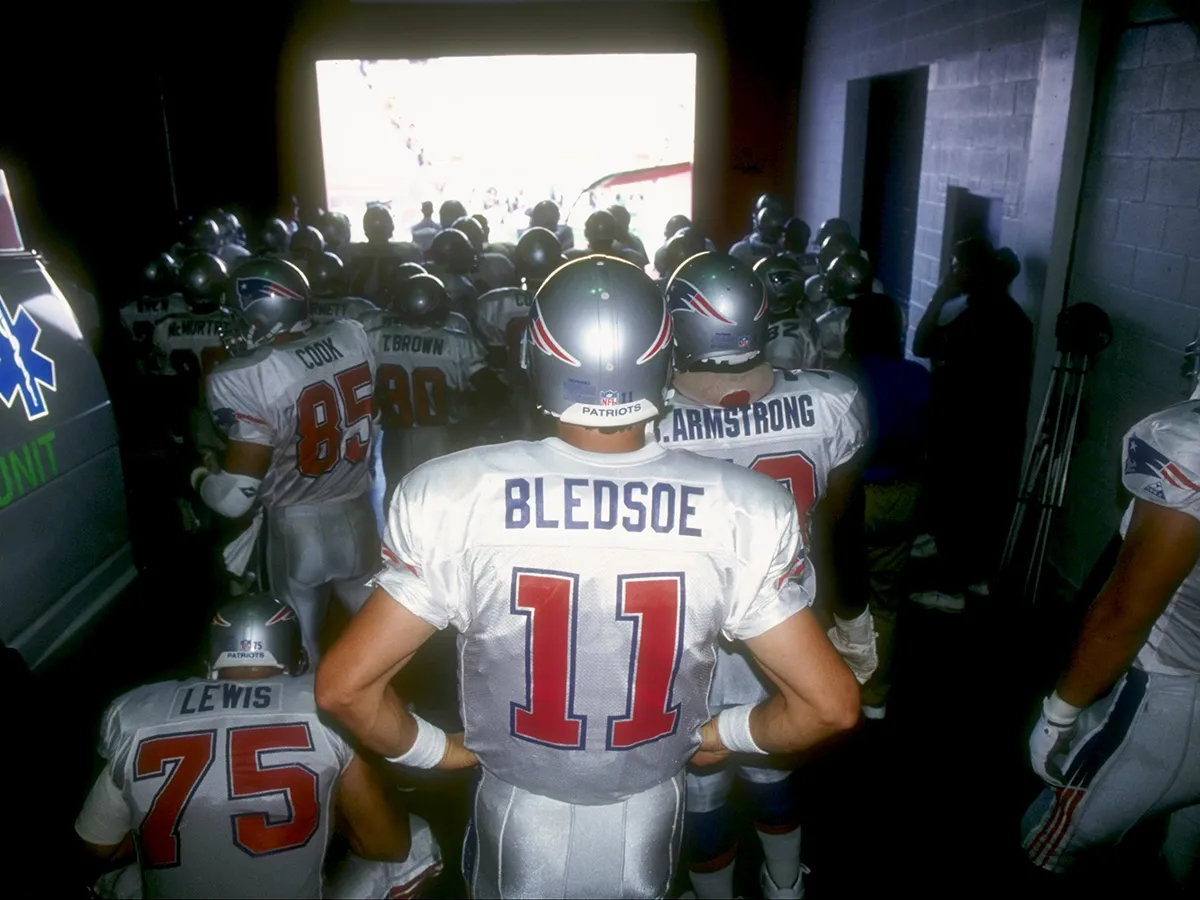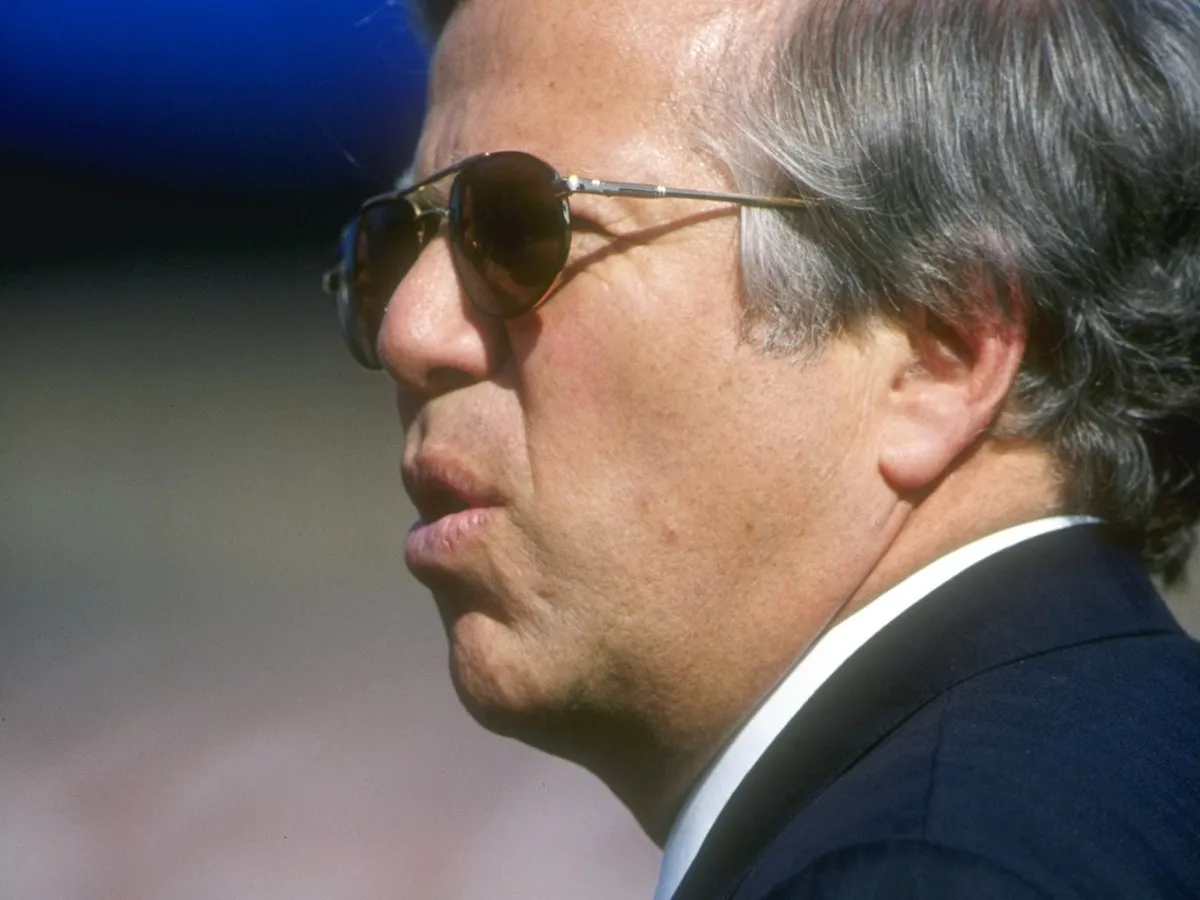Today’s New England Patriots are football royalty. But a quarter-century ago, the franchise nearly moved halfway across the country. From those uncertain days emerged a mid-’90s team that won the fans back and changed the narrative on Patriots football.
Part one of a three-part series.
On Jan. 26, 1997 – 25 years ago – the Green Bay Packers won Super Bowl XXXI. The indelible images of the night include Brett Favre running with his helmet aloft, Desmond Howard alone in a sea of green turf, and the scoreboard displaying a 35-21 final as Reggie White thrust the Lombardi trophy in the direction of the Superdome roof.
The Packers’ opponent in New Orleans had been 14-point underdogs. They lost by 14. And when all was said and done, the AFC had come up short against the NFC for a 13th consecutive time.
But those snapshots and numbers don’t tell the story of the 1996 New England Patriots.
Twenty-five years of unprecedented success later, it’s easy to forget just how much the team meant to the region.
“That season’s not talked about enough,” says former Pats All-Pro and Super Bowl champ Lawyer Milloy. “That was the beginning.”
As three-time Super Bowl champion Ted Johnson notes, “You can’t tell the story of the 2001 Patriots without talking about the 1996 Patriots.”
It almost didn’t happen.

Defensive back Willie McGinest #55 and linebacker Chris Slade #53 both of the New England Patriots jump for joy at the Patriots stopping the Jacksonville Jaguars on the 4th down in the AFC Championship game at Foxboro Stadium in Foxboro, Massachusetts on Jan. 12, 1997. The Patriots won 20-16. (Photo by Rick Stewart/Getty Images)
Rewind another four years, to the winter of 1993. The Pats hadn’t made the playoffs in six years. They’d lost a combined 50 games over the previous four seasons. They were last in attendance. Third-to-last in merchandise sales. A franchise that had made it to the ‘86 Super Bowl (their lone appearance in team history) had faded into obscurity.
“The Patriots were No. 4 [on the Boston pro sports scene] in a big way,” Boston Globe columnist Dan Shaughnessy told the Kraftwork podcast in 2018.
“I didn’t watch the Patriots much growing up in Southern California,” Johnson remembers. “They weren’t on much.”
“I didn’t really know anything about who played in New England or what major city it was near,” admits Milloy. “I got drafted and was like – oh, s***, I’m going to London somewhere.”
The stadium was as nondescript as the team. The Pats toiled in one of the worst venues in the league: a facility built on the cheap in way back in 1971. It hadn’t aged well, and you could probably say the same for some of the fans of who inhabited it.
“The place was a s***hole and everybody was drunk,” remembers Joe Murray, co-host for Patriots postgame coverage on 98.5 The Sports Hub. “It was crazy. I had a buddy at a Dolphins game who wore a Dan Marino shirt and got punched in the face. He didn’t say or do anything. He just had a Miami Dolphins shirt, and got punched in the face.”
“No seats, just a sliver of metal bench,” recalls Pats fan Brian Brickley of Acton. “The benches would burn your ass when the sun was shining and froze when the temperatures dropped.”
“There was nothing to like about the stadium. The most charm the place had was the greyhound track in the parking lot.”

General view of a mist-enshrouded playoff game between the New England Patriots and Pittsburgh Steelers at Foxboro Stadium in Foxboro, Massachusetts on Jan. 5, 1997. The Patriots won the game, 28-3. (Mandatory Credit: Al Bello/Allsport)
The owner of the team at the time was James B. Orthwein, who’d bought the Pats from cash-strapped electric razor magnate Victor Kiam in 1992.
“I was there for Victor Kiam,” recalls former quarterback Scott Zolak. “They’d bring out a folding table, put out a bunch of ties and razors and say “Merry Christmas.”
While the St. Louis businessman’s publicly stated desire was to turn around the franchise and flip it to a local buyer, Orthwein was also the head of a group looking to bring the NFL back to the Gateway City. While the league was considering adding two expansion franchises (which became the Carolina Panthers and Jacksonville Jaguars), you couldn’t help but wonder if Orthwein would try to uproot the Pats. And he almost did.
“It was real,” Zolak remembers. “I actually have a St. Louis Stallions hat. It was purple and gold.”
Wherever the team was to be located, they needed a coach. And somehow, Orthwein wound up reeling in a big one. While the Pats interviewed such coaching luminaries as Mike Ditka, Buddy Ryan and Dan Reeves, as well as future Eagles head man Ray Rhodes for the vacant job, one name blew everybody out of the water: Bill Parcells.
Why would the Big Tuna, a two-time Super Bowl champion with the Giants, choose the Patriots?
“Because I felt good, and I look forward to returning to the profession,” Parcells said at the time. “We are what we are, and Bill Parcells is a football coach.”
With the top pick in the upcoming NFL draft and a new tool known as free agency at Parcells’ disposal, Orthwein also afforded the veteran leader the autonomy he lacked in New York: a verbal agreement that he ran the show with respect to personnel decisions.

Bill Parcells, Head Coach for the New England Patriots during the American Football Conference East game against the Buffalo Bills on Dec. 18, 1994 at Rich Stadium, Orchard Park, Buffalo, New York, United States. The Patriots won the game 41-17. (Photo by Simon Bruty/Allsport/Getty Images)
Then, of course, there was his legendary coaching style.
“Everything changed,” Hall of Fame linebacker Andre Tippett told Bill Burt of the Eagle-Tribune back in 2013. “You knew he had those two Super Bowl rings. That meant something because we didn’t have any.”
“Right away, he held everyone accountable…it was a culture shock.”
“Bill knew exactly which buttons to push with all 53 guys in that locker room,” muses Zolak. “We hated it. We couldn’t wait for game days so we could get away from him.”
“Bill’s the head coach, and I always felt that whatever way he wanted it done, that’s the way we were going to do it,” current Patriots coach Bill Belichick – a onetime Parcells assistant – told A Football Life. “That really wasn’t even debatable.”
Says Johnson: “He’s the best coach I’ve ever been around…if you were one of the few who were quote-unquote ‘Parcells guys,’ you just knew if you were. He doesn’t come up to you, put his hand on your shoulder and say it. You just know.”
With the No. 1 pick, the Pats selected Drew Bledsoe, a 6-foot-5 junior with a missile for a right arm who’d guided an unheralded Washington State team to nine wins and a Copper Bowl victory the previous year.

5 Sep 1993: Quarterback Drew Bledsoe of the New England Patriots prepares to get onto the field for a game against the Buffalo Bills at Rich Stadium in Orchard Park, New York. The Bills won the game, 38-14. Mandatory Credit: Rick Stewart /Allsport
“I was a fan of Drew’s from Wazzu,” says Johnson. “I remember there was this game (the 1992 Apple Cup against Washington). He was in the middle of driving snow. It was one of the most incredible games from an aesthetic standpoint: watching Drew throw the ball around in that driving snow.”
Parcells also nabbed linebacker Chris Slade, tackle Todd Rucci, and receivers Vincent Brisby and Troy Brown in the ‘93 draft.
Results weren’t immediate. Parcells milked just three more wins out of his roster than Dick MacPherson had the previous campaign. But New England ripped off four consecutive victories to close the season, highlighted by a wild 33-27 overtime victory over the Dolphins in the finale.
Bledsoe hit Michael Timpson on a 36-yard bomb (his fourth TD of the day) to secure the win.
Just weeks after the season ended came more good news: the Pats would have a local owner. Two years after buying the team, Orthwein was out and businessman Robert Kraft – a longtime season ticket holder who bought Foxboro Stadium out of bankruptcy in the 80s – dropped $172 million in the transaction, the highest in the NFL to that point.

13 Oct 1996: Robert Kraft looks on during a game between the New England Patriots and the Washington Redskins at Foxboro Stadium in Foxboro, Massachusetts. The Redskins won the game, 27-22. Mandatory Credit: Simon Bruty/Allsport
Kraft had spent a decade preparing for this moment. But his willingness to go above and beyond was motivated in part by fan reaction at the finale, a game some thought might be the last one played in New England.
As team president Jonathan Kraft told the Kraftwork podcast: “As we were riding down the elevator, he looked over at me and said, ‘There’s no – blanking – way we’re not buying this thing.'”
At the 1994 draft, New England grabbed linebacker Willie McGinest out of USC with the fourth overall pick. Tackle Max Lane was selected in the sixth round. But again, the team scuffled.
By mid-November, the Pats were 3-6, with Warren Moon and the 7-2 Vikings coming to town. Minnesota piled up a 20-0 lead by the second quarter. Few could predict what would come next.
Bledsoe unleashed a record 70 passes, connecting on 45 of them (also a record), piling up 426 yards through the air. He found Brisby on 4th-and-10 to extend a fourth quarter drive and push the game into overtime, then lofted his third touchdown pass of the day into the hands of fullback Kevin Turner to seal a 26-20 victory in OT.
New England would win seven consecutive games, making the playoffs for the first time since 1986.
Belichick, then coach of the Cleveland Browns, would kill the dream dead on Wild Card weekend.
But, for the time being, the New England Patriots – nearly the purple and gold Stallions of the Midwest – were gaining momentum.
NEXT: Spirit of ’96, Part 2: Patriots learn to fly
Sean Sylver can be heard on 98.5 The Sports Hub. You can find him on Twitter @TheSylverFox.


